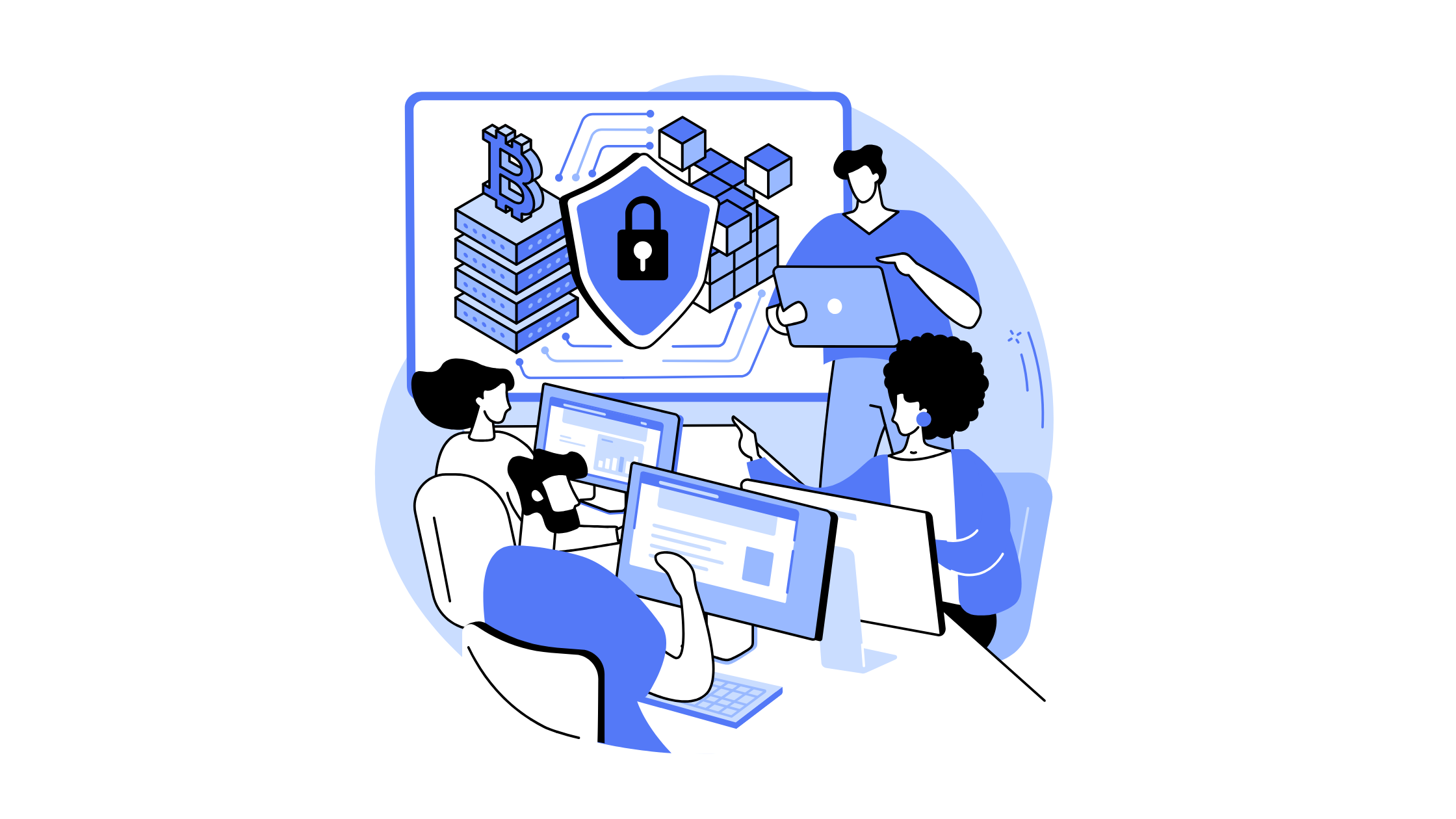Blockchain technology has emerged as one of the most transformative innovations of the digital age, revolutionizing the way we think about trust, security, and efficiency in various industries. While often associated with cryptocurrencies like Bitcoin, blockchain’s potential extends far beyond digital coins. In this comprehensive article, we will delve into the world of blockchain technology, exploring its history, its fundamental elements, its workings, the participants in blockchain networks, and how these aspects collectively contribute to transparency, trust, security, and efficiency.
Definition and History of Blockchain
Blockchain, in its essence, is a decentralized and distributed digital ledger that records transactions across multiple computers. The term “blockchain” is derived from its structure: a chain of blocks, each containing a list of transactions. But its history goes back further than its popular association with cryptocurrencies.
A Brief History
The conceptual foundation of blockchain technology was laid out in a whitepaper titled “Bitcoin: A Peer-to-Peer Electronic Cash System” published in 2008 by an entity or person under the pseudonym Satoshi Nakamoto. This whitepaper introduced Bitcoin, the first cryptocurrency, and the blockchain technology that underpins it.
Bitcoin’s creation was, in essence, a response to the global financial crisis of 2007-2008. It aimed to provide an alternative to traditional centralized banking systems and fiat currencies, offering a peer-to-peer digital cash system that could function without intermediaries. Bitcoin’s success and subsequent proliferation led to the recognition of blockchain as a revolutionary technology.
Beyond Cryptocurrencies
However, it’s important to note that blockchain’s significance goes far beyond cryptocurrencies. While cryptocurrencies remain one of the most visible applications of blockchain, this technology has found utility in countless other sectors, including finance, supply chain management, healthcare, voting systems, and more. Blockchain’s core principles-decentralization, transparency, security, and immutability-are adaptable to a wide array of use cases, making it a versatile tool for innovation.
Blockchain revolutionizes the way we trust, transact, and interact in the digital world. By providing transparency, security, and efficiency, it eliminates the need for intermediaries, fosters trust among users, and opens up a world of possibilities across various industries. Whether in finance, healthcare, supply chain, or beyond, blockchain’s decentralized and tamper-proof nature has the potential to reshape how we conduct business, share information, and build a more secure and interconnected global ecosystem through its elements of Distributed Ledger Technology (DLT), Immutable Records and Smart Contracts.
Elements of Blockchain: Distributed Ledger Technology, Immutable Records, and Smart Contracts
Distributed Ledger Technology (DLT)
At the core of blockchain technology is Distributed Ledger Technology (DLT). DLT is a system for recording transactions that is distributed across multiple nodes or computers. These nodes work together to validate and record transactions, ensuring that the ledger is maintained across the entire network. This decentralization is a key feature of blockchain, as it eliminates the need for a central authority.
DLT ensures that the ledger is resilient to attacks, as tampering with one node’s copy would be futile since the majority of nodes would have an accurate record. This robustness enhances security and trust.
Immutable Records
The concept of immutability is fundamental to blockchain. Once data is recorded in a block and added to the chain, it cannot be altered or deleted. This is achieved through cryptographic hashing, where each block contains a reference to the previous one. Any change in the data would require the consensus of the majority of nodes in the network, making it practically impossible to tamper with the records.
Immutability is critical for maintaining trust in the blockchain. Users can be confident that once a transaction is recorded, it remains unchanged, providing a reliable and tamper-proof history of transactions.
Smart Contracts
Smart contracts are self-executing agreements with the terms of the contract directly written into code. These contracts can automatically execute actions when predefined conditions are met, without the need for intermediaries. Smart contracts operate on the “if-then” principle: if a certain condition is met, then a specific action is automatically carried out.
Smart contracts enhance efficiency and trust in business processes. They reduce the potential for disputes, eliminate the need for third-party intermediaries, and ensure that agreements are executed precisely as specified.
Benefits of Blockchain
Blockchain technology offers a multitude of advantages that reshape the landscape of modern operations;
Inevitable Transparency:
Transparency lies at the heart of blockchain’s significance. In traditional systems, such as centralized databases or financial institutions, information is often siloed and controlled by a central authority. In contrast, in the world of blockchain, there’s no need to place unwavering trust in a central authority through providing a decentralized ledger that is visible to all participants. Every transaction recorded on the blockchain is transparent and immutable, meaning that once a transaction is added, it cannot be altered or deleted without consensus from the majority of the network. This transparency ensures that anyone can verify the integrity of the data, fostering trust among users.
Greater Security:
The decentralized nature of Distributed Ledger Technology (DLT) coupled with the immutability of blockchain data forms a formidable fortress of security. Attempting to tamper with blockchain data necessitates seizing control of the majority of the network, an exceptionally daunting task that reinforces the sanctity of the data. This heightened level of security makes blockchain a compelling choice for industries and applications where data integrity is paramount.
Generates Trust
Trust is the foundation of many business and social interactions. Blockchain technology creates trust through its transparency, security, and the absence of intermediaries. Users can have confidence in the accuracy and reliability of the data recorded on the blockchain, knowing that it cannot be altered.This trust extends to smart contracts, self-executing agreements with terms directly encoded in code. Smart contracts automate processes and execute actions when predefined conditions are met, eliminating the need for intermediaries and reducing the potential for disputes.
Efficiency of Doing Business
The efficiency gains brought about by blockchain technology are significant. Traditional financial systems involve numerous intermediaries, resulting in delays, additional costs, and the potential for errors. In contrast, blockchain enables peer-to-peer transactions and automation through smart contracts, streamlining processes and reducing administrative overhead. One of the elements of blockchain; Smart contracts act as digital workhorses, automating processes and driving efficiencies that were once considered unattainable. These self-executing agreements eliminate the need for laborious manual interventions and intermediaries, significantly reducing both time and costs. In complex business operations, where precision and speed are vital, this newfound efficiency becomes a game-changer, allowing organizations to optimize their processes and allocate resources more effectively.
In supply chain management, for example, blockchain’s transparency allows for real-time tracking of goods, reducing delays and fraud. In healthcare, blockchain can simplify and secure the sharing of patient records among providers, enhancing the speed and quality of care.
How Blockchain Works: A Simple Overview
Understanding how blockchain works is crucial to appreciating its power. Essentially, a blockchain is like a digital ledger made up of blocks, each holding a bunch of transactions. Here’s a simplified overview of how blockchain operates:
- Transaction Initiation: When someone wants to do something on a blockchain, like sending digital coins or recording information, they tell the whole network about it.
- Transaction Verification: The network, which consists of many computers (nodes), checks if the action is legit. They look at digital signatures, make sure there’s enough digital stuff (like coins) to do the action, and see if it follows the blockchain’s rules.
- Transaction Bundling: Once a bunch of actions are verified, they get bundled together into a block. This block is like a container that holds these actions. Importantly, each block also points back to the block before it, forming a chain of blocks, hence “blockchain.”
- Consensus Mechanism: Before a new block is officially added to the blockchain, the network has to agree on it. They do this using something called a consensus mechanism. It’s like everyone in the group needs to say “yes” for the block to join the chain.
This whole process repeats over and over, with new actions turning into new blocks, and the blockchain keeps growing. The beauty of it is that once something is in a block, it’s super hard to change. This makes blockchain a trustworthy and secure way to do all sorts of things beyond just digital money.
Blockchain Use Cases
Blockchain technology has transcended its origins in the realm of cryptocurrencies to emerge as a potent force of innovation with far-reaching applications across diverse industries. Its ability to infuse transparency, trust, security, and efficiency into digital processes has ignited a wave of transformation across wide range of industries. Lets discover compelling use cases of blockchain.
Intellectual Property
- Copyright Protection: Blockchain helps creators protect their intellectual property by timestamping and proving ownership of content.
- Royalty Distribution: Smart contracts automate royalty distribution to creators when their work is used or sold.
Supply Chain Management
- Provenance Tracking: From food to luxury goods, blockchain can track the origin and journey of products, ensuring authenticity and minimizing fraud.
- Inventory Management: Real-time tracking of inventory reduces waste, enhances efficiency, and ensures products are available when needed.
- Supplier Verification: Blockchain helps verify supplier credentials and certifications, ensuring compliance with regulations.
Energy Sector
- Grid Management: Blockchain supports efficient energy grid management, enabling peer-to-peer energy trading and demand response systems.
- Carbon Credits: The technology can track carbon credits and emissions, making it easier to manage and reduce carbon footprints.
Healthcare
- Patient Records: Blockchain secures patient data and enables patients to have greater control over their records, facilitating secure sharing with healthcare providers.
- Drug Traceability: Ensuring the authenticity of pharmaceuticals by tracking their supply chain journey helps combat counterfeit drugs.
- Clinical Trials: Transparency in clinical trials data helps ensure the integrity of research and results.
Education
- Credential Verification: Blockchain verifies academic credentials, reducing credential fraud and simplifying the hiring process.
Secure Storage: Student records can be securely stored and accessed with user consent.
The Blockchain Evolution
Blockchain has transcended its origins, stretching far beyond the confines of cryptocurrencies like Bitcoin, to reshape industries and redefine our approach to trust, security, and efficiency across versatile industries.
This comprehensive journey through the world of blockchain has unraveled its fascinating history, delved into its essential elements of Distributed Ledger Technology, Immutable Records, and Smart Contracts, and explored its far-reaching benefits. The blockchain’s decentralized and tamper-proof nature has not only eliminated intermediaries but has also paved the way for transparent, secure, and efficient processes. As we’ve witnessed, blockchain’s impact extends from intellectual property to supply chain management, healthcare, energy, education, and beyond, bringing unprecedented innovation to each sector. With a simplified understanding of how blockchain works, it becomes evident that this technology is more than a revolution; it’s a digital evolution that holds the promise of a more secure, interconnected, and efficient future. Blockchain has ignited a spark of innovation, and its flames continue to light the path forward for industries and individuals alike, as we navigate the ever-expanding possibilities of the digital age.




